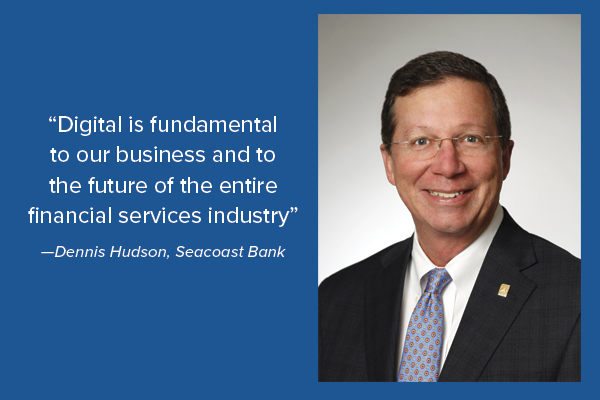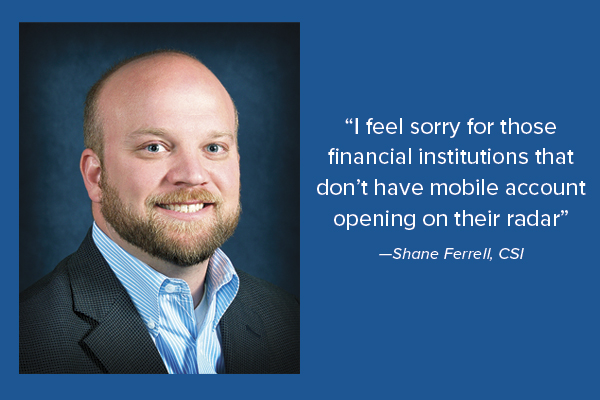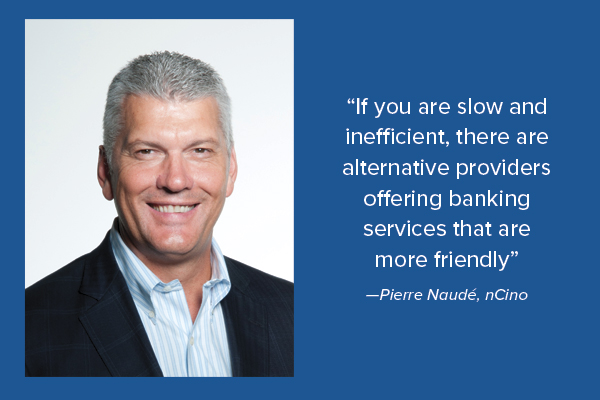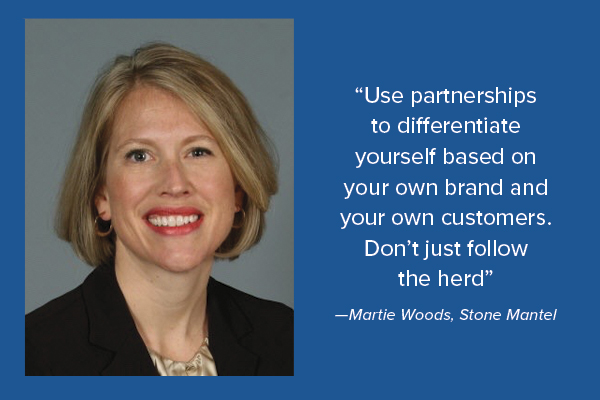Digital strategy: Does your bank have one?
Mobile account opening, fintech partners, analytics, and more all must blend for success
- |
- Written by Lisa Joyce
 Coming up with the right digital strategy will be critical to your bank’s future.
Coming up with the right digital strategy will be critical to your bank’s future.
Ask Florida-based Seacoast Bank if it has a digital strategy, and the answer will be a resounding, “Yes!”
“Digital is fundamental to our business and to the future of the entire financial services industry,” says Denny Hudson, CEO of the $4.3 billion-assets bank. He explains that the traditional bank model that was built upon the premise of face-to-face and paper transactions is crumbling.
Strong word, “crumbling.”
Hudson goes on, “We built banks and developed systems that dictated how customers should behave in order to do business with us. We now need to service customers in ways that are far more convenient for them.”
At Fifth Third Bancorp, digital engagement also is a critical strategy. The company has experienced a 25% growth in mobile adoption from 2014 to 2015, notes Melissa Stevens, chief digital officer and head of omnichannel for the $140 billion-assets Cincinnati-based regional. The key to digital engagement, she says, is to understand the needs and behaviors of customers so you can be there for them the moment they need you.
Going even further up the size scale, digital is a critical component of $1.7 trillion-assets Wells Fargo & Co.’s customer engagement strategy as well, says Brett Pitts, head of digital for Wells Fargo Virtual Channels. “Mobile has become the primary way in which millions of our customers interact with us daily. Customers have higher expectations of their interactions with us. They expect it to be easy for them to cross channels.”
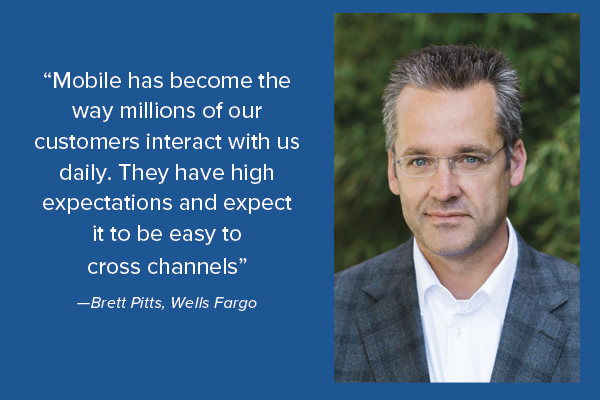
These three banks have embraced the digital disruption that is happening in the financial services industry. Even business leaders outside this industry anticipate the change.
In the survey Digital Pulse 2015, which was conducted by Russell Reynolds Associates, 61% of executives said they believed that consumer financial services would be moderately or massively disrupted by digital in the next 12 months. The only industries that these executives thought would be more disrupted were media (72%) and telecom (64%).
Where do banks fit?
What is the role of traditional financial services institutions in a digital world?
The good news is that while technology companies often offer greater transaction speed and convenience, traditional financial institutions often win out when it comes to more complex financial dealings, where experience and trust are important.
According to the Nielsen Company’s Digital Enablement for Retail Banking, 84% of mass affluent baby boomers and 81% of mass affluent millennials—defined as consumers with between $250,000 and $1 million in liquid assets—believe it’s very important to use a highly reputable and well-known financial institution when choosing financial products, such as mortgages.
Further, 84% of mass affluent boomers and 79% of mass affluent millennials value a knowledgeable financial broker or advisor to help them make financial decisions.
Most sources agree financial institutions will need to retain their traditional value proposition while deploying digital. Key factors for success include mobile account opening, rethinking branches, partnering with fintech firms, retooling how banks set strategies, and increasing the use of analytics and predictive modeling.
Let’s explore each of these factors.
1. Mobile account opening
Online account opening has been around for some time, and quite a few financial institutions offer it as a customer convenience and to reduce operating expenses, although often it’s rolled out as a competitive response. Mobile account opening is the next logical step, and dozens of options exist.
Says Shane Ferrell, vice-president of digital strategy for bank technology company CSI: “I feel sorry for those financial institutions that don’t have mobile account opening on their radar. Customers aren’t coming into the branch to open accounts. They want convenience.”
Although customers are becoming increasingly comfortable trying mobile account opening, the process still has its kinks. Four out of ten customers abandon the account opening process, according to Signicat’s report The Battle to On-Board. More than one-third (39%) of these customers abandon the application because account opening takes too long, and 34% abandon the application because they are asked to supply too much personal information.
Consider the typical mobile account opening process, and it’s clear that it’s clunky, frustrating, and time consuming.
To meet know-your-customer requirements, banks must electronically identify a customer’s identity using primarily a credit bureau search and queries to electronic identity verification providers. If a customer can’t be verified, the bank asks him to come into the branch to present identity documents—an inconvenience.
Says Pierre Naudé, CEO of nCino, a provider of bank operating systems: “Mobile account opening needs to be more streamlined and efficient. Customers don’t want any back and forth. They expect all documentation to be handled effectively through the app. Why can’t I take a photo of my driver’s license and check? Why do I need to come into a branch to open an account?”
If the mobile account opening process could be completed all digitally, 55% of respondents in Signicat’s survey would be more likely to apply. For those respondents who have had a negative experience applying for an account digitally, 64% indicated they would apply again if the application were completely digital.
Solutions have emerged that offer mobile interfaces that allow customers to submit electronic copies of identity documents, such as drivers licenses and passports, utility bills, and photo selfies.
Mitek, for example, offers ID Checker for mobile verification of identity documents. The solution uses the camera on a mobile phone to scan the identify information and verify authenticity. It also can prefill forms based on the scan, explains Sarah Clark, general manager of the Identity Business Unit.
Mitek also is working on using biometrics as an identity tool. “We will support the ability for customers to take a selfie and allow the bank to cross-check that photo with the ID supplied. Real-time authenticity verification solves the problem banks have of being assured they know who the customer at the end of the device is and removes any friction for customers,” explains Clark.
She notes that a streamlined, simplified account opening process is important, particularly for banks that want to attract the unbanked, underbanked, and millennials.
2. Rethinking branches
Someday, a discussion of digital banking will occur without any mention of physical branches. For now, the conversation continues, and, with good reason, there’s much at stake in getting it right.
We’ll start with the views of nCino’s Naudé, notable because he is head of a bank technology company. Naudé believes that with the ongoing movement to digital engagement, the number of branches will continue to decrease. However, he warns bankers not to underestimate the importance of a physical location.
“Branches will serve larger geographic areas,” he predicts, “but with a higher level of service and engagement due to user-friendly technology.”
Not everyone agrees that branches will remain relevant. Luvleen Sidhu, cofounder and chief strategy officer at the completely digital BankMobile, a division of Customers Bancorp, Wyomissing, Pa., states that the average retail branch has only 1,400 to 1,500 checking accounts, and only opens about one new account per week.
“Branches are an inefficient model that is being subsidized by banking fees,” says Sidhu. The BankMobile model, in contrast, is designed to reduce the burden of fees by helping underbanked, millennial, and middle-income Americans have an affordable, effortless, and financial empowering banking experience, she says.
Branches do continue to play a role at Customers Bank, although the bank is not adding branches. Says Sidhu, “Customers Bank has grown from about $1 billion in assets to about $10 billion in assets without adding branches, and we expect to keep doing that.”
BankMobile relies on a direct-to-consumer sales model plus distribution partnerships to attract and retain customers. One example: BankMobile offers software to 800 colleges and universities that enables them to distribute financial aid refunds to students. One option given to students is to deposit the refund into a BankMobile account.
“We acquire between 400,000 and 500,000 new student accounts a year with zero branches,” says Sidhu.
Once students open an account, BankMobile works to engage them by rewarding them for positive behaviors, such as good grades, paying bills on time, and saving. Since students often struggle to build a credit score, BankMobile has created what Sidhu calls a quasi-credit score based on their behaviors. This score helps students gain access to credit from BankMobile once they graduate. It also helps the bank better evaluate credit risk.
Branches are becoming less relevant to Seacoast Bank, which has quietly closed about 13 of 40 legacy branches with zero impact on business, according to Jeff Lee, chief marketing officer. However, the bank also has expanded into new markets through acquisition and organic growth, using analytics to determine the value of acquired customers.
3. Impact of fintechs
In this world of digital disruption, banks face competition not only from other financial institutions, but from the host of so-called fintech firms as well.
Naudé with nCino calls the fintech revolution a “wake-up call” for banks.
“If you are slow and inefficient,” Naudé warns, “there are alternative providers offering banking services that are more friendly.”
But banks do have an advantage over fintech firms, which have a higher cost of money and funding.
“The cost of capital is about 6% for fintech firms,” notes Naudé, “while the cost for banks is about 1%.”
Even though banks can lend money to customers at lower rates, however, customers have demonstrated they will pay more for the convenience and access a fintech firm can provide, says Naudé.
Financial institutions and fintech firms can work together. Explains CSI’s Ferrell: “There are fintech firms that are good partners, and their sales models support bank partnerships. Even direct-to-market fintech companies are changing their approach and seeking partnerships with financial institutions.”
Martie Woods, lead strategist with consultancy Stone Mantel, agrees, saying that financial institutions, big and small, can benefit from fintech partnerships.
“The biggest mistake banks make is following each other,” says Woods. “This contributes to commoditization. Use partnerships to differentiate yourself based on your own brand and your own customers. Don’t just follow the herd.”
It can be tricky for institutions to identify what differentiates them in the market, acknowledges David Edmondson, senior managing director of Accenture’s North America Banking practice.
Edmondson suggests that banks determine what is a differentiator and what is a commodity, and then partner with fintech firms to offer that differentiator. Only a handful of financial institutions will be able to compete on scale and therefore price, notes Edmondson. The vast majority will need to compete on customer experience.
At BankMobile, for example, fintech partnerships are critical, and in Sidhu’s mind, the lines between financial institution and fintech firms are blurry.
“We view ourselves as a fintech company that happens to have a bank charter,” she says. “We have the cheap funding and customer acquisition that fintech firms struggle with. We have the best of both worlds.”
BankMobile plans to become the “Amazon of financial services,” says Sidhu, by leveraging strategic partnerships.
“Fintech partners will be under the BankMobile umbrella,” she explains. With these partnerships, BankMobile plans to expand into wealth advisory, student loans, personal lending, and more.
(Amazon, meanwhile, is following a similar path, though in reverse, as it partnered recently with Wells Fargo for wealth management services.)
4. Nimble strategic planning
In traditional bank strategy planning, executives and board members attend an annual off-site retreat to set the strategic plan. But with new fintech market entrants and a rapidly changing digital environment, once-a-year planning is not enough.
“Banks need to be able to adapt and have a flexible model in how often they meet, says Ferrell of CSI. “While it’s important to have a long-term strategic plan, institutions need to be nimble and change their strategy more than once a year.”
For many banks, an annual strategy planning session quickly turns into an annual operating planning session.
“Executives and the board tend to set the budget rather than focus on strategy,” says Woods. Instead, she recommends focusing on the big picture, such as defining the role banks play in customer lives.
“True strategic planning is a shift for bankers who tend to think about functions rather than how their customers think. Products are just a means to an end,” says Woods.
“We are continually planning,” says Seacoast’s Hudson. The bank recognized in 2011 that it needed to not only change its strategy, but make changes to its board to closely align with the bank’s transformation to more digital delivery. One-half of the team is new to the bank within the last four years. Although some have bank experience, others hail from outside the industry. Says Lee, “Talent, both on the board and on the executive team, is a critical component of our strategy.”
The executive team and board meet at least every six months, in addition to regular board meetings, and spend about 85% of that meeting time discussing strategy.
“We have a constant and evolving focus on technology strategy and the fundamental shift in our business model,” says Hudson. “We are making massive changes in how we come to market, which is driving revenue growth and profitability. These strategic changes are also better for our customers as well.”
“This is a fascinating time for banks,” adds Hudson. “We are in an industry in which usage of our highest cost channels is declining and our lower cost channels are exploding. There’s got to be a way to turn that into real success.”
Stevens of Fifth Third says that what works now is creating a strategic road map and then constantly tweaking it.
“Be ready to pivot on the strategy based on customer needs, how the world is changing, and regulations. The model of setting the strategy and marching up the hill won’t work due to all the disruption going on in the digital world,” she advises.
5. Analytics and predictive modeling
Wells Fargo organizes data around the end-to-end customer experience to be more proactive on their behalf, notes Pitts. “We’re focused on not just big data, but smart data that allows us to use our data faster and more effectively.”
At much smaller Seacoast Bank, technology plus analytics form the foundation for the bank’s digital offerings, says Lee. And that technology is no longer out of reach of smaller banks due to high costs. Seacoast uses 400 different data elements to drive cross-sales across eight channels.
“Ten years ago, the cost of this software would be unattainable for a smaller bank,” explains Lee. “Today, that software has become democratized.” IBM software powers the bank’s cross-sell engine while SAS provides analytics.
At any given time, Seacoast runs up to 40 different cross-sales campaigns. Campaigns can be designed in minutes and target customers based on behavior. In addition, the bank can easily measure the results of any outreach to refine campaigns on the fly.
The results are impressive. Data-driven cross-sell fueled a consumer loan production increase of 57%, and cross-sales of new deposit accounts to existing customers rose 47% in 2015.
A recent campaign sought to increase debit card use. The bank identified customers with underutilized debit cards, and used outbound calling and emails to incent them to activate their cards with a reward.
“We’ve had great growth in interchange revenue,” says Hudson.
Fifth Third also is a big believer in the power of analytics and modeling.
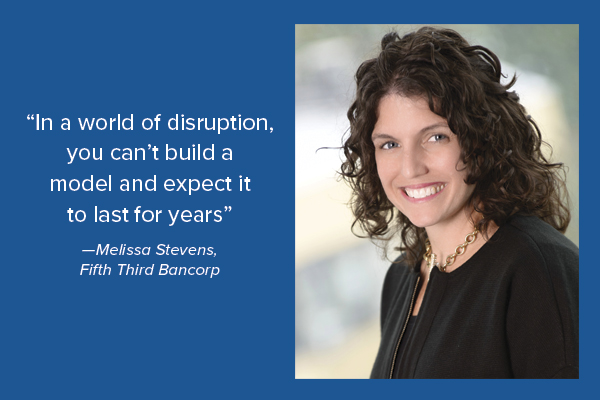
“The transformation being driven by data and analytics is huge,” says Stevens. “We must anticipate the needs of customers and derive insight from their behaviors.”
Because analytics and modeling toolsets change quickly and the amount of data is overwhelming, focus on what is most important, build a model, learn from that model, and move on.
“You can’t build a model and expect it to last for years in a world of disruption,” says Stevens.
Stevens adds, “If we are not using data and building models that help us help our customers get to where they want to be in their lives, then we, as banks, are not working hard enough. We need to earn customers’ business every day.”
At the right time
Mobile alerts drive increased banking frequency. According to Forrester’s June 2016 report What Drives Mobile Banking Usage, consumers who are set up to receive account alerts log into their banking app nearly two more days per month than customers who don’t use alerts. Banks can consider introducing new alert types and making it more convenient for customers to manage alerts within the mobile banking app.
Sending the right message at the right time resonates with Woods. But that right time has as much to do with the customers’ state of mind as it does with their location or what they are doing on the app or online.
Woods subscribes to consultant Clayton Christensen’s jobs-to-be-done framework that contends that customers organize their thinking around different modes.
Here’s how it works. When a customer is depositing a check using their mobile phone, chances are good he or she is in productivity mode and focused on completing a task. This is not the time for the bank to interject with an offer for a home equity line of credit. Even if the customer has a need for a HELOC, they will be more likely to decline the offer.
However, send a relevant message while the customer is in an exploring mode—researching travel or home improvement—and they will be more likely to react positively.
“Banks need to think about modes and catch people in the right frame of mind,” says Woods.
Where to go from here?
We’ll close with two related thoughts reflecting different perspectives.
Digital can be hugely effective as a transactional tool, notes Woods, and although it can play a role in such aspirational or emotional type functions as retirement planning or estate planning, customers almost always want a person-to-person touch at some point.
When defining a digital strategy, remember what happened to video industry giant Blockbuster, cautions Seacoast’s Lee:
“An industry can change quickly, and Blockbuster rode the old model too long. A high fixed-cost structure will kill you in a rapidly changing environment.”
Tagged under Management, Lines of Business, Technology, Fintech, Feature, Feature3,












